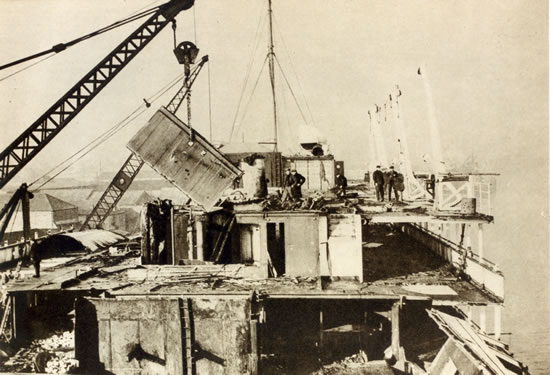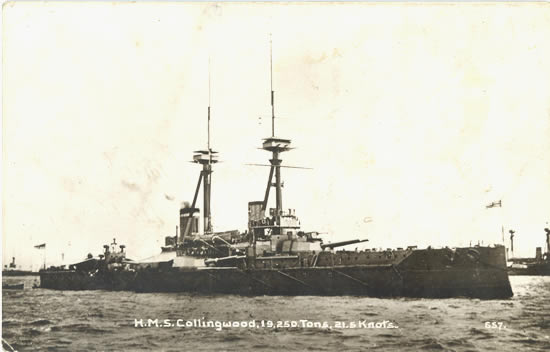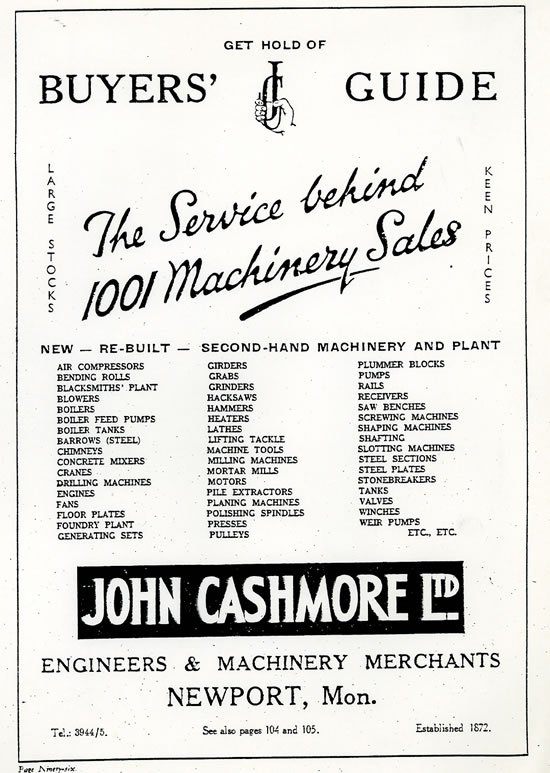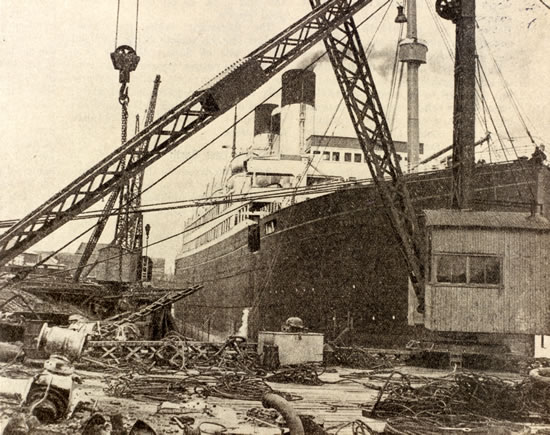John Cashmore
Everything Iron And Steel
By Jim Dyer
© Jim Dyer 2012
It was clear that John Cashmore, a Staffordshire man, was an excellent businessman and it was this ability that noticed the benefits of establishing a breaking-up complex on the banks of the tidal River Usk in Newport, South Wales. The Usk was documented to have the second highest tidal reach in the world which enabled large vessels to navigate upstream. Between 1972 and 1976 over 1,000 ships, of all sizes, were scrapped there; famous warships, ocean- going liners, paddle steamers, tugs and coasters were pulled apart - the metal and accessories sold and re-cycled. Added to this collection were scores of steam trains during the Beeching era, colliery and other plant equipment and fundamentally anything which could be broken-up.

By 1937 over 280 ships had been broken-up.
It was a sad day in 1979 when Cashmores closed but memories still abound to this day of ships being towed to the wharf and the excited children watching the spectacles. Wood, doors, chairs and other furniture still survives in the city, salvaged and sold by Cashmore.
This article gives a brief history of the firm.
Beginnings
Cashmores's influence as a major benefactor and entrepreneur in the town and across the Bristol Channel was to spread throughout the globe in his quest for new contracts. Schemes of every description were undertaken. By 1937 the firm was a premier employer in the Monmouthshire town with seafaring traditions since the Romans set up a base in Caerleon upstream.
The firm was noted for handling iron and steel, dealing with new and rebuilt machinery, works dismantling and shipbreaking. 'Everything Iron and Steel' became its logo.
When the owners of Weston-Super-mare Pier decided the extension was no longer needed, the difficult demolition contract was awarded to Cashmore. In the 'thirties, the last Newport trams were scrapped followed by steam trains in the 'sixties. Campbell's pleasure paddle steamers ended their days at Blaina and Russell Wharves as did railway rolling stock and anything else that could be sold or recycled. Often viewing was open to the public and quality fittings for sale at reasonable prices.
He recognised Newport's advantages; a fast growing town on a tidal river, abounding business expertise particularly in coal exporting and the spin-offs of maritime trade. The docks and river were choked with vessels from around the world. His business flourished because of modern working practices and revolutionary new metal cutting equipment.
In a short period Cashmore had established an international company worth millions of pounds and a reputation of swiftness, reliability and competiveness rarely matched today. By 1937 over 280 ships had been broken-up. After closure in the late 70s the business was incorporated into the Gynwed Group but the Cashmore name is still recalled in the city.
Development
Cashmore was not slow in advancing his business and his early publicity handooks he praised his operations :
' in 1872 in a small town in Staffordshire was started a business to buy and sell scrap iron and metals. The beginnings were small but with each succeeding year adding more and more business until today there is hardly a town of any size where some contract has not been carried out by my firm.'
HMS Collingwood, the powerful old battleship, was broken-up in record time in 1922 - one year and three months. Being a generous benefactor to the town he donated the public viewing proceeds to the local Royal Gwent Hospital.

HMS Collingwood. 19250 tons 21.5 knots
The firm was one of the largest dismantling companies in the Midlands and South Wales - always looking to purchase blast furnace plants, ironworks, collieries electrical installations, brickyards, gasworks, ships, dredging plants. all types of scrap, ferrous or non-ferrous, and heavy machinery. his aim was always efficiency and thoroughness. Nothing was too big or too small.
'....today the purchase of a liner - one of the proud and stately floating mansions - tomorrow a small tug or barge........'
He boasted too :
'We have our own private berths equipped with powerful electric cranes up to forty tons capacity and travelling steam cranes lifting from three to ten tons. Our facilities for loading and unloading both import and export goods, and for discharging scrap material is unrivalled in the Bristol Channel'
Activities
His Newport business address was the Old Town Dock but the headquarters were at Great Bridge Staffs. Here he had a depot, Tudor and Onions and another at Cochrane and Company. But in Newport the breaking activities were carried out.
'When my firm commenced operations in Newport many were sceptical, their minds going back to previous attempts all of which ended in failure. Today over 1,500 ft of river frontage is busily occupied in this one industry. Newport can now boast of the largest private firm of ship breakers in Great Britain. over 350 men are employed and what were once obsolete and deserted wharves are today hives of industry; busy, keen and happy workers doing their best to retain in this country a business that is threatened and attacked by continental competition'
In the thirties Cashmore set out the extent of his acquisitions and offered for sale works premises at Bradley near Bilston. One of the largest undertakings ever purchased in the Midlands for dismantling was Cochranes Ltd at Dudley. At one time this was the largest pipe founders in the world; equally famous as blast furnace proprietors and girder builders. Cashmore dismantled the plant with the exception of a portion of the iron foundries.
Cashmores Woodside Slag Crushings works was tops in efficiency. From here he sold slag macadam, grit and clinker. Deliveries were made by road or rail.
At Adderbury, near Banbury, he owned 113 acres of ironstone mines and leased 64 acres adjoining. These were connected with the Great Western Railway with permanent sidings and a system of 24 inch gauge tramway. Some 15,000 tons of ironstone wre being produced per acre.
Electrical plant was another lucrative branch and many public bodies gave contracts to Cashmore to dismantle. He always carried a stock of electrical spares and equipment.
During the 'twenties depression he was given contracts to dismantle collieries throughout the country. He bought them as they stood for a lump sum. Other contracts included piers. a carpet factory, gas works, an Elizabethan mansion.
So many aspects of this Newport company but it is the ship breaking that stands out in the towns history.

Cashmore's Advert
Competition
There were about 60 other shipbreakers in the country at this time though some relatively small. Some were equal to Cashmores but his advantage lay in the fact he could deal with all ship sizes and had ready outlets for scrap.
One competitor was J E Thomas also in Newport but smaller. Others in South Wales were Cohen of Briton Ferry, Cardiff Marine Stores Wards, and Rees of Llanelli. Ward had several yards and there were other competitors in the West Country.
Cashmore also undertook breaking for ships bought by others such as HMS Verity, a destroyer, bought by British Iron and Steel Federation in 1947. Similarly in 1969 SS Manitoba was broken up for British Steel and the large steel making complex at nearby Llanwern.

Between 1972 and 1976 over 1,000 ships, of all sizes, were scrapped there;
famous warships, ocean- going liners, paddle steamers, tugs and coasters were pulled apart
- the metal and accessories sold and re-cycled.
Terms Of Trade
Generally vessels were purchased on the following basis:
1. Scrap price subject to market price of scrap metal;
2. Calculated on the basis of light displacement tonnage;
3. E.g. - scrap (ton) £3 x 100 (light disp) = £300;
4. Price paid was the price for delivery at Newport;
5. Owners responsible for delivery;
6. Any tonnage or pilotage fees were deducted from the final price paid as were the berthing fees.
Continuation of Company
The founder, John Cashmore died in 1932 at the age of 92. The family continued to run the firm as more and more business was attracted.
In 1939 the Board of Directors were :
Frederick W Cashmore, Ernest E Cashmore, Harold V Cashmore, John Venables, Arthur Smith and John E Cashmore.

The 1939 the Board of Directors: Frederick W Cashmore, Ernest E Cashmore, Harold V Cashmore, John Venables, Arthur Smith and John E Cashmore
Venables later became Managing Director followed by his son Stuart. The Board was backed-up by expert office staff and workforce.
By this time there had been some changes in the thrust of the business although old activities were substantially retained. Now they were advertising reconditioned and new machine tools. Their distinctive letterheads indicated the firms interests -- machine tools, electrics, steam plant, marine plant, contractors plant, foundry plant, steel sections, MS plates, shafting and pulleys, tubes and fittings, and engineers stores.
At the outbreak of World War Two they circulated a letter for the collection of scrap for the war effort. Scrap was essential.
The prosperity of the firm continued through the fifties and 'sixties. They had a substantial trade in steam engines and rolling stock. Their Yard became a graveyard of rusting boilers and wheel bogies and a playground for the children of Pillgwelly. At the same time old ships made their last voyages up the Usk.
By 1976 the Company for so many years a part of town life, struggled in the economic climate. In March of that year they closed their warehouses at a cost of 76 jobs. This was followed in October by closure of ship breaking operations.
It was the French minesweeper Aldebaran which was the last ship scrapped there. Today the largest ship breaking yard is at Kaohsiung Taiwan. The prophetic words of John Cashmore about the threat of foreign competition appear to have been well-founded..
Jim Dyer - 20 Dec 2011
NOTES
1. A full and detailed list of all the ships scrapped at Cashmores is included in the Maritime Documents deposited at Newport Central Library by the author.
2. Much of this information was gathered from former employees and references in the South Wales Argus.